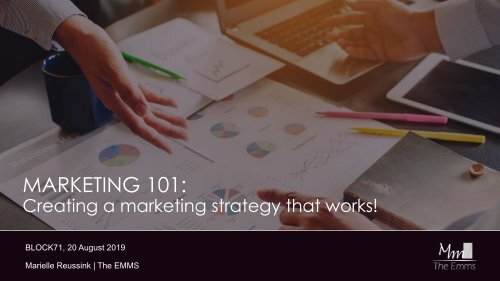Block71 MARKETING 101 Session 20 August 2019 - Handout
Create successful ePaper yourself
Turn your PDF publications into a flip-book with our unique Google optimized e-Paper software.
<strong>MARKETING</strong> <strong>101</strong>:<br />
Creating a marketing strategy that works!<br />
BLOCK71, <strong>20</strong> <strong>August</strong> <strong>20</strong>19<br />
Marielle Reussink | The EMMS
WHY DO<br />
STARTUPS FAIL?
Top 10:<br />
Of the top 4, 3 are Marketing related!<br />
1. No market need: Selling the wrong products or services.<br />
2. No marketing plan; no or too small marketing budget; poor marketing.<br />
3. No clear value proposition and differentiation vs. competitors.<br />
4. Not being able to identify and reach the right customer.<br />
5. Wrong pricing and lack of control over costs.<br />
6. Poor product or service delivery. Ignore customer feedback.<br />
7. Ineffective business model.<br />
8. Personal (wrong team, internal disharmony, burnout, lose focus, lose passion etc.)<br />
9. Lack of investment and funding.<br />
10. Losing track of the market
How can marketing be<br />
that important?
Good Marketing is:<br />
• Strategic<br />
• Goal oriented<br />
• Measurable<br />
• Based on research, analysis & understanding of your target audience, market<br />
dynamics and competitors<br />
• Driven and optimised by data<br />
• Impacts your entire business: product development, distribution, sales, advertising<br />
and promotion
Objective for today?<br />
Learn to think about your marketing<br />
strategically, so you can do what’s right<br />
for your business!
Strategic Marketing will help you to:<br />
• Be clear on your goals.<br />
• Be clear on your target audience.<br />
• Identify and communicate your value.<br />
• Clarify why customers should choose you.<br />
• Help you invest in the right channels.<br />
• Improve the quality of your website traffic.*<br />
• Improve conversions.*<br />
• Improve how you’re spending your marketing budget.<br />
• Ensure you’re doing more of the right things to achieve your goals and make your business<br />
a success.<br />
*Assuming you have a well-designed site.
So how does it work?
Step 1:<br />
Define your objective.
Branding<br />
Can your target audience identify you? Do<br />
they know what you stand for?<br />
Understanding the funnel<br />
– and YOUR challenges<br />
Awareness<br />
Does your target audience know about<br />
your business?<br />
Education<br />
Does your target audience understand<br />
your business, what you do and how you<br />
solve their problem?<br />
Consideration<br />
Do they know what makes your business<br />
unique and why they should choose you?<br />
Do they clearly understand your value<br />
proposition?<br />
Conversion<br />
Do they become a lead and buy your<br />
products or services?
Always be conscious of what you want to achieve, what<br />
your challenges are and never lose sight of your goals!<br />
Whether it’s awareness, branding, education,<br />
consideration or conversion, your strategy should be<br />
focused on helping you achieve your aims.<br />
Your goals will determine your entire strategy. If they<br />
shift, your KPIs will change and your strategy needs to<br />
adapt!
Step 2:<br />
Know your audience.
Who’s your target customer?
I don’t know…
Everyone?
If you don’t know who your target customer is, how can<br />
you find them?<br />
If you can’t find them, how can they buy your product or<br />
service?<br />
If no one buys your product or service, how will your<br />
business survive?
You need to know your<br />
target customer!
Based on that you can choose the right channels and<br />
design communications that push all the right buttons.<br />
So take a step back and think about it… Who is your<br />
target audience? What makes them tick?<br />
How is your product or service relevant to them? What<br />
problem are you solving and in what scenario?<br />
How can you reach them in these situations?
Step 3:<br />
Select your channels.
Channel Overview<br />
Digital:<br />
Facebook<br />
Instagram<br />
LinkedIn<br />
Twitter<br />
YouTube<br />
Pinterest<br />
Snapchat<br />
Display Ads/Banner Ads<br />
Website<br />
Search Engine Marketing/Paid Search/AdWords<br />
Blogging<br />
Email Marketing<br />
SEO<br />
Digital directory listings<br />
Offline<br />
Speaking Engagements<br />
Events<br />
TV<br />
Radio<br />
PR<br />
Out of home (billboards etc.)<br />
Print (magazines, newspapers etc.)<br />
Collateral (Flyer, Brochure, Poster etc.)<br />
Other<br />
Affiliate Marketing<br />
Influencer Marketing<br />
Community Building<br />
Word of Mouth
How do you<br />
choose?
Selecting the right channels for your communications<br />
can feel daunting. To make the right choice, you need to<br />
understand what a communication channel can do for<br />
you.<br />
- Is it designed to achieve your goals?<br />
- Can it reach your target audience?<br />
- How does your target audience use the channel?<br />
- Is that in line with your needs?<br />
Once you have a good understanding of this, you have<br />
the information you need to make an informed decision.
Step 4:<br />
Create your message!
The magic behind successful Marketing<br />
is consistency and clarity!
Get clear on your Value<br />
Proposition & your Brand!
Be inspired by the biggest brands<br />
in the world!<br />
Source: Forbes, Jan <strong>20</strong>18.
They don’t sell products.
They sell an experience!
They tell a story!
And so should you!
What makes a good story?
2 + 1:<br />
Value Proposition & Brand<br />
Story type
Step 5:<br />
Implement!
The secret to success lies in the<br />
implementation!
Writing:<br />
Your writing is compelling, it is relatable to the reader,<br />
it is written in a tone that is true to your brand and in a<br />
style that is appropriate for the channel, it conveys<br />
your value proposition, your differentiation and why<br />
someone should choose you. It has a clear call to<br />
action.
Visuals:<br />
Your visual communications, including images and<br />
videos, tell a story that compliments your text. They are<br />
in line with your brand and reinforce the brand<br />
experience. They are of good quality; they are assets<br />
you are proud to use. They have been created keeping<br />
the medium and how the user interacts with it in mind,<br />
ensuring that it is the right size and format.<br />
All your communications should have visuals.
Channel:<br />
You understand the channel, you understand how it<br />
works and how you can maximize your ROI using it. You<br />
know what formats are right for the channel you’re<br />
using, the tone of voice you should be using. You also<br />
know that it is optimised and designed to help you<br />
achieve your goals and that it can reach your target<br />
audience.
Step 6:<br />
Measure, learn, refine.
Measure, learn…<br />
Then adapt your strategy.
Find out what’s the benchmark<br />
Ensure your expectations are<br />
achievable!
Education/<br />
Engagement<br />
Awareness<br />
Consideration<br />
Conversion<br />
Typical Metrics & Benchmarks - Digital:<br />
Reach<br />
How many people are seeing your<br />
content.<br />
Impressions<br />
How many times people are exposed to<br />
your content.<br />
Frequency<br />
Frequency<br />
How many times people have been<br />
exposed to your<br />
3<br />
content.<br />
Followers<br />
How many new people are following<br />
your page.<br />
Engagement<br />
How many Reactions, Comments and<br />
Shares your content gets.<br />
Engagement Engagement<br />
Rate<br />
Rate<br />
The likelihood of people engaging with<br />
content vs. reach<br />
5%<br />
or impressions.<br />
Website Traffic<br />
How many people visit the website.<br />
Clicks<br />
How many people click to go through to<br />
the website as a result of your content.<br />
Click-through Rate<br />
Click-through Rate<br />
The likelihood of people clicking through<br />
to the website as 2% a result of your<br />
content vs. reach or impressions.<br />
Conversions<br />
How many people become a lead or<br />
make a purchase.<br />
Conversion Conversion<br />
Rate<br />
Rate<br />
The likelihood of people becoming a<br />
lead or making<br />
1 a<br />
- purchase<br />
2%<br />
vs. reach.<br />
Cost per Conversion<br />
The average cost per lead or purchase<br />
made.
Branding<br />
How many people do you need to reach?<br />
Objective: Sales<br />
Awareness<br />
You need to reach 250,000 people to<br />
reach your target<br />
Education/Engagement<br />
2%<br />
Consideration<br />
5000 people need to go to your website<br />
2%<br />
Conversion<br />
Target: 100
Set-up concrete metrics in relation to your goals to<br />
assess whether your strategy is working.<br />
Track your metrics regularly. Understand your metrics;<br />
understand what they are telling you.<br />
Learn from this data to make informed decisions and get<br />
better every day.<br />
Adapt your strategy based on these learnings, not on a<br />
whim.
6 Steps to Success<br />
Step 1:<br />
Define your Goals<br />
Step 6:<br />
Measure, Learn and Refine<br />
Step 2:<br />
Know your Audience<br />
Step 5:<br />
Implement<br />
Step 3:<br />
Select your Channels<br />
Step 4:<br />
Know your Message
That’s strategic marketing.
Contact:<br />
Marielle Reussink<br />
mreussink@the-emms.com<br />
+65 85221874<br />
www.the-emms.com<br />
<strong>MARKETING</strong> ON A MISSION!




